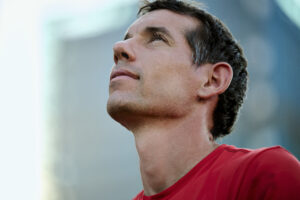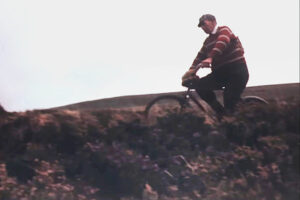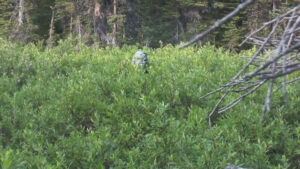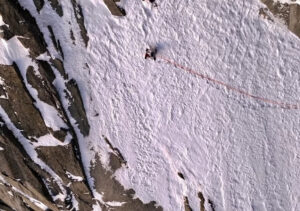In a crowded field of climbing films that are increasingly hard to tell apart, Mike Call’s The Artist kept me guessing. My notes are tangled and scrawled, and (perhaps largely due to personal reasons) would be stained with saline if I’d been leaning over the paper instead of backward.
Can you expect the son of this woman to portray a mundane hero?
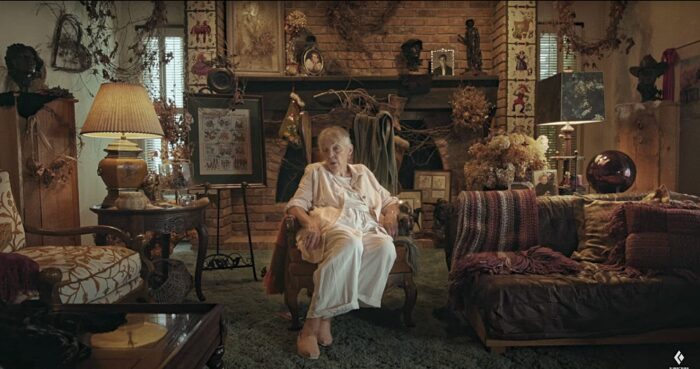
Sue Speed, mother of rock climbing legend Boone Speed at home. Photo: Screenshot
Let me explain what I mean by “kept me guessing.”
Here’s a linear story arc The Artist could follow:
Boone Speed anchored sport climbing in the 1990s, burning a trail through American Fork Canyon that fried everyone not named Chris Sharma. Then he played an instrumental role in inventing modern bouldering gear and creating the market for it. Then he became a world-class photographer.
All along, his unforgiving personality burned just as hot as his ambition. He ostracized some of his closest friends. Everything he did “put a dent in the world,” in Call’s words, but he appeared to pay the price for it. It looked like he couldn’t break through whatever membrane was keeping him restless in his own skin.
Then later in life, he cooled off — realizing, as he says in the film, that his oldest relationships are the most important thing. He sums up the epiphany with a familiar sentiment: “How much better does it get?”
All of that’s true. But, like all art, there’s what The Artist appears to do, and then there’s what it actually does.
Here’s what it actually does:
Describes Speed’s early dynamism from behind the lens
Call was Speed’s earliest videographer. Three decades later, their relationship is the same. But instead of depicting a one-dimensional Speed by handing him the narrative reins, Call tells it his way — which adds depth to his subject right away.
Emphasizes real-world outcomes
Introducing key mentors like Maria Cranor, Black Diamond’s marketing director while Speed was embroiled in generating the modern bouldering market, provides accountability. Cranor and other key influences create rules and boundaries for young Speed, shaping his decisions.
Pusher, a company that Speed helped found, wasn’t just a collective of heathens. It was the first climbing company that paid no attention to anything except bouldering. Pusher sold an aesthetic involving T-shirts, ads, and some seminal videos. It also made climbing holds.
Allows its aesthetics to penetrate
The Artist exalts the aesthetic principle of reduction: Do more with less. You can see it in Speed’s interior decoration, with demure houseplants and a small reproduction of one of his father’s sculptures. It’s also the principle he applies to guide his photography.

Speed’s eye. Photo: Screenshot
And if you’ve ever climbed, you know how to apply it.
The film stays out of the way, allowing emotive expression from images, colors, and interview subjects alike.
Pumps the gas — but doesn’t over-rev
Speaking of Speed’s father, don’t miss the son describing how he felt after his father died. But don’t expect lingering close-ups of misty eyes or quivering lips. Call knows the viewer can feel every bit of the moment’s pathos without having their head dunked in a bucket of it.
(For the record, yes, this is the part that got me choked me up.)
Elsewhere, skip to 14:10 for peak tough-guy Boone.
Focuses on the art, not the artist
So The Artist doesn’t focus on the artist?
Correct, it does not. Instead, it watches what the artist is watching: his subjects. In a way, Speed is the hero of the film. But not really. Because it’s actually about everyone except him.

Sam Elias, photographed by Speed, on ‘The Big Smile,’ 5.14a
In the fat part of the bell curve of climbing films, production crews can labor in dramatics, saturated visuals, or tired storylines.
Another segment in the big part of the curve is the predictable. We watch a climber trace a typical heroic cycle of accepting challenge, faltering, transforming, and eventually meeting the challenge to achieve redemption.
The Artist pretends to be both; instead, it’s neither.
There’s more to explore that way.


